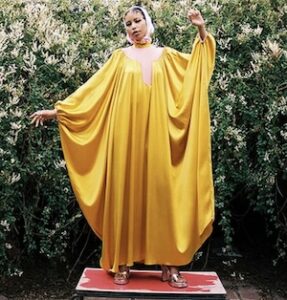Monochrome Piece of Art: From One Colour to Another
By Timi Ayeni
Many paintings from art galleries and museums are painted in multiple tones and hues making them vibrate and alive. But some artists use only a single colour in a painting. Monochrome in art means one colour or hue which can use with different shades and tones. Historically the use of single-hue images started in the 20th century and is still being explored even today. Find out in Monochrome Piece of Art: From One Colour to Another
This form of art explores both the potential emotions and textures of artworks using the smallest amount of one tone of paint. Compositions show uniqueness and boldness in the making of abstract art.

It first began in 1918 when supremacist artist Kazimir Malevich painted a composition titled ‘White on White’ as a sequel to his 1915 work ‘Black Square on a White Field’, which was his most important 20th-century work to date.
Suprematism was one of the key movements of modernist art. In 1927 Malevich published his book The Non-Objective World, one of the most important theoretical documents of abstract art.
‘In the year 1913, trying desperately to free art from the dead weight of the real world, I took refuge in the form of the square.’
Out of the ‘suprematist square,’ as he called it, Malevich developed a group of forms that included shapes such as rectangles, triangles and circles often in simple bold colours. These forms floated against a white ground, with a feeling of colour in space in suprematist painting is a crucial aspect of it.
From the white-on-white painting, the idea of exploring one colour or tone became an ‘essay’ for many others to explore.
Gerhard Richter
Gerhard Richter born in 1932 is a German visual artist who has produced abstract as well as photorealistic paintings, photographs and glass pieces.
He is widely regarded as one of the most important contemporary German artists and several of his works have set record prices at auction. He produced a series of monochrome, all-grey paintings, right after unveiling a set of vibrantly coloured works as his explorations of grey have prompted him to explain his interest in the hue.
Frank Stella
Frank Stella born in 1936 is an American painter and sculptor who is noted for his work in the areas of minimalism and post-painterly abstraction with his black painting series.
Four paintings were the start of a series of 23 Black Paintings, as well as his reputation as a shocking and talented artist. Setting the stage for minimalist artists everywhere, Stella’s Black Paintings sought to separate themselves from human experience and instead create a new visual literacy.
Olivier Mosset
Olivier Mosset born in 1944 is a Swiss visual artist dedicated to exploring and eradicating fixed ideas of what it means to be an artist. He is best known for his large-scale monochromatic pieces. Mosset’s art can be thought of as self-evident and devoid of metaphor.
He produced over 200 identical oil paintings of a small black circle in the centre of a white square canvas from 1966-1974 with repetitive patterns and the abolition of subjectivity.
Christopher Wool
Christopher Wool born in 1955 is an American artist and painter born in 1955; his art has since incorporated issues surrounding post-conceptual ideas in the 1980s.
He is known for his use of monochrome including oil paintings of large black stenciled letters on a white canvas which he applies layer upon layer of white paint to the works.
Sir Anish Kapoor
Sir Anish Kapoor born in 1954 is a British-Indian sculptor who specialises in installation and conceptual art. He is known for his geometric or biomorphic sculptures using simple materials such as granite, limestone, marble, pigment, and plaster.
His notable public sculptures include Cloud Gate (2006, also known as “The Bean”) in Chicago’s Millennium Park; Sky Mirror, exhibited at the Rockefeller Centre in New York City in 2006 and Kensington Gardens in London in 2010.
Robert Holyhead born in 1974 is a British abstract artist whose monochrome work is marked by expanses of white ground left uncovered with traces of colour at the canvas edge where paint has been carefully removed from the surface.
Ryan Travis Christian born in 1983 is an American post-war and contemporary artist whose work involving 1990’s suburban Chicago backgrounds has offered up absurd experiences which he uses to fuel up the surreal personal narratives in his pop-culture-influenced graphite drawings.
He was influenced and impacted by Chicago-style figuration, in which he focuses on the paradoxical relationship between childish cartoons and ominous messages, musing on the technological and material obsolescence of his inspiration.
However, he exposes the untidy lifestyle of contemporary humanity through a vast array of topics and imagery; the economy, the environment, gender, class, hope, and doubt are contemplated with drugs, heavy petting, alcohol, violence, depression, death, and the afterlife.
Robert Ryman
Robert Ryman born in 1930 was an American painter who identified the movements of monochrome painting, minimalism, and conceptual art. He was best known for abstract, white-on-white paintings on his artwork. He died in 2019 at the age of 88.
Ad Reinhardt
Adolph ‘Ad’ Reinhardt born in 1913 was an abstract painter active in New York for more than three decades.
He was a member of the American Abstract Artists and part of the movement centred on the Betty Parsons Gallery which became known for the movement of abstract expressionism.
He was mostly famous for his “black” or “ultimate” paintings, he claimed to be painting the “last paintings” that anyone can paint.
He also believed in a philosophy of art he called Art-as-Art and used his writing and satirical cartoons to advocate for abstract art and against what he described as “the disreputable practices of artists-as-artists”. He died in 1967 at the age of 53.
Yves Klein
Yves Klein born in 1928 was a French artist and an important figure in post-war European art as he was a leading member of the French artistic movement of Nouveau réalisme.
He began to paint in the late 1940s and formulated his first monochrome theories at his first public one-man exhibition, at the Galerie des Solitaires in Paris in 1955. His early monochrome pictures were in orange, yellow, pink, red and green, but from 1957 he worked mainly in blue paint which became iconic.
His 1957 exhibition, ‘Proposte Monocrome, Epoca Blu’ (Proposition Monochrome; Blue Epoch) featured 11 identical blue canvases, using ultramarine pigment described by Klein as “The Medium”.
Discovered with the help of Edouard Adam, a Parisian paint dealer, the optical effect retained the brilliance of the blue pigment which, when suspended in linseed oil, tended to become dull, where the added resin kept it bright.
Klein later deposited a Soleau envelope (proof of priority for inventions valid in Franc) for this recipe to maintain the “authenticity of the pure idea. It became known as International Klein Blue (IKB). He died very young in 1962 at the age of only 34.
Lucio Fontana
Lucio Fontana born in 1899 was an Argentine-Italian painter, sculptor, and theorist. He is mostly known as the founder of Spatialism, synthesising colour, sound, space, movement, and time into a new type of art.
Trained initially as a sculptor, Fontana rejected the traditional constraints of artistic materials and techniques, choosing instead to invent his own media and methods in response to the rapidly changing world he inhabited.
However, he reinterpreted the physical and theoretical limits of art by considering artworks as concepts of space, often using surprising gestures that created holes and cuts in canvases to reveal unseen spatial regions as he embraced paradoxes, destroying physical and intellectual traditions to create new discoveries of art. Although not using colours as such his work was about a lack of tone but the importance of texture.
Josef Albers
Josef Albers born in 1888 was a German- American artist who is recognized as one of the foremost leaders in monochrome and colour theory.
Albers’ homage to his Square painting series is comprised of four superimposed oil-applied squares on a Masonite panel. Never painted, his pieces were applied from a palette knife directly onto the panel, and the technical details for the creation of these pieces were meticulously recorded on the backs of each.
The series was created to explore the deceptiveness of colour, and the importance of visual perception, Albers’ book Interaction of Colour, published in 1963, showed the culmination of this seminal exploration.
Ellsworth Kelly
Ellsworth Kelly born in 1923 was an American painter, sculptor, and printmaker associated with hard-edge painting, colour-field painting and minimalism.
His works demonstrate unassuming techniques emphasizing line, colour, and form. Many of his paintings consisted of a single, often bright colour, with some canvases being of irregular shape, sometimes called “shaped canvases.”
Robert Rauschenberg
Milton “Robert” Rauschenberg born in 1925 was an American painter and graphic artist whose early works anticipated the Pop art movement. He was well known for his Combines series which is a group of artworks that incorporates everyday objects as art materials, and which blurred the distinctions between painting and sculpture.
Monochrome art has changed the perspectives of how we look and see colours in paintings and abstract artists using single-coloured images. Artists from different generations have continued on with this style that is complex and deeply emotive in nature.
If you enjoyed reading Monochrome Piece of Art: From One Colour to Another, why not read Exploring the Parallel and Connected World of Food and Art
. Cent magazine London, Be Inspire; Get Involved





